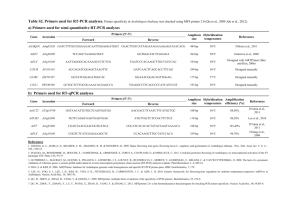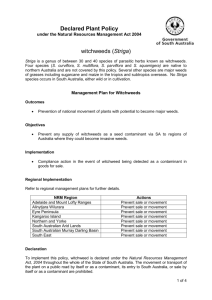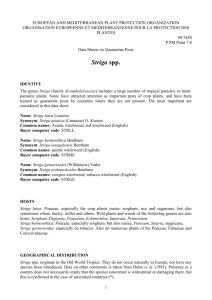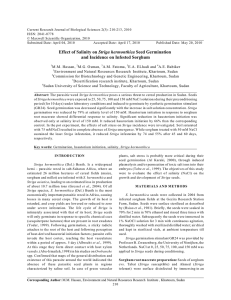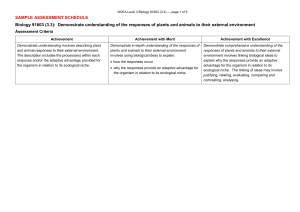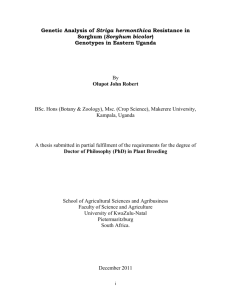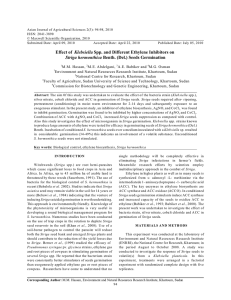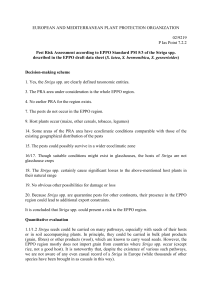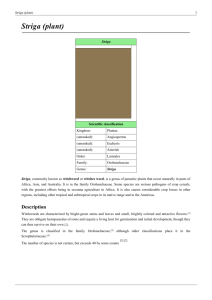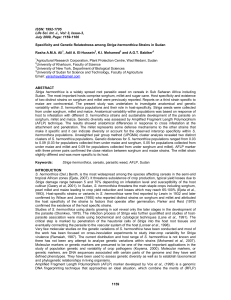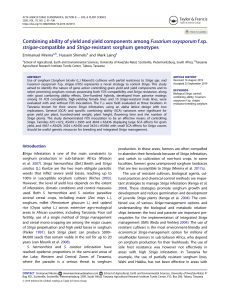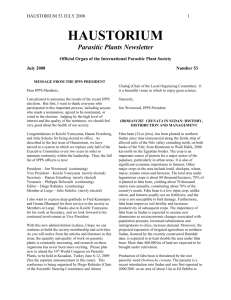nph12692-sup-0001-MethodS1-S5-FigS1-S4
advertisement
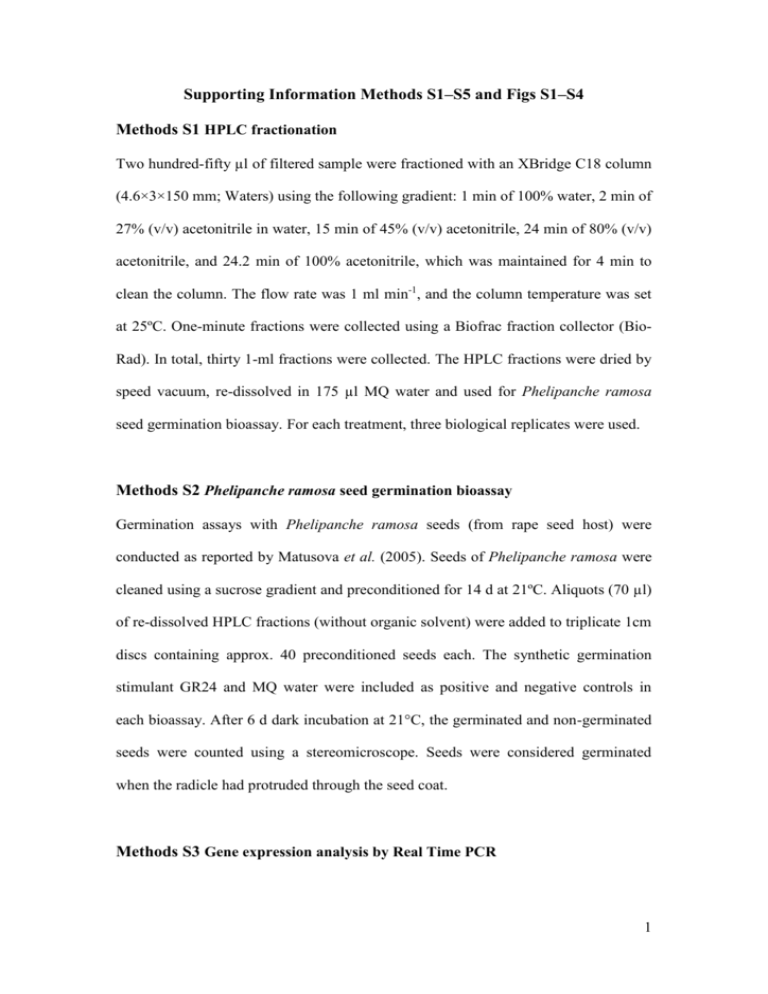
Supporting Information Methods S1–S5 and Figs S1–S4 Methods S1 HPLC fractionation Two hundred-fifty µl of filtered sample were fractioned with an XBridge C18 column (4.6×3×150 mm; Waters) using the following gradient: 1 min of 100% water, 2 min of 27% (v/v) acetonitrile in water, 15 min of 45% (v/v) acetonitrile, 24 min of 80% (v/v) acetonitrile, and 24.2 min of 100% acetonitrile, which was maintained for 4 min to clean the column. The flow rate was 1 ml min-1, and the column temperature was set at 25ºC. One-minute fractions were collected using a Biofrac fraction collector (BioRad). In total, thirty 1-ml fractions were collected. The HPLC fractions were dried by speed vacuum, re-dissolved in 175 µl MQ water and used for Phelipanche ramosa seed germination bioassay. For each treatment, three biological replicates were used. Methods S2 Phelipanche ramosa seed germination bioassay Germination assays with Phelipanche ramosa seeds (from rape seed host) were conducted as reported by Matusova et al. (2005). Seeds of Phelipanche ramosa were cleaned using a sucrose gradient and preconditioned for 14 d at 21ºC. Aliquots (70 µl) of re-dissolved HPLC fractions (without organic solvent) were added to triplicate 1cm discs containing approx. 40 preconditioned seeds each. The synthetic germination stimulant GR24 and MQ water were included as positive and negative controls in each bioassay. After 6 d dark incubation at 21°C, the germinated and non-germinated seeds were counted using a stereomicroscope. Seeds were considered germinated when the radicle had protruded through the seed coat. Methods S3 Gene expression analysis by Real Time PCR 1 Total RNA was isolated from Striga tissues using TRIzol reagent (Invitrogen, USA) and further purified with RNAeasy mini spin columns (Qiagen, USA). Quality and quantity of the DNase-treated RNA samples were assessed by Agilent Bioanalyzer 2100 analyses (Agilent Technologies, USA) and determined to contain high quality RNA with no DNA contamination. First strand cDNA was synthesized using high capacity cDNA reverse transcription kit (Applied Biosystems). Taqman chemistry was used to measure the expression level of the targeted strigolactone genes in S. hermonthica. Primers used for ShCCD7 were a forward, 5’-ACGCGCCGAGACCTC3’, a reverse 5’-CCGGGAGGGCGGATG-3’, and a probe, 5’- CTCCCCGTCATCAGCG-3’. Primers used for ShCCD8 were a forward, 5’GCAAAGAGCTGGATGGAAAACG-3’, a reverse 5’-TTCGTGGCCCGTCCG-3’, and a probe, 5’-ACCCTCCGAACCCTTC-3’. Primers used for ShMAX2 were a forward, 5’-CCGACACGAACGCCTTGT-3’, a reverse 5’- AGAGTAGCTGCGTTGATCTTAGC-3’, and a probe, 5’-GACGAGCGCGAGGG3’. For each developmental stage, three biological replicates and two technical replicates were used. Real time RT-PCR was performed in 7300 real-time PCR system (Applied Biosystems) using a cycling regime of 95ºC for 30 s followed by 40 cycles of 95ºC for 15 s and 60ºC for 1 min. The default parameters of SDS 7300 system SDS software were used to determine the threshold cycle (Ct). The number of transcript copies were calculated based on an external standard curve and subsequently normalized based on input cDNA quantity. The reference gene used was S. hermonthica Ubiquitin 1, using primer sequences and amplification conditions exactly as described in Fernández-Aparicio et al. (2013). The normalized values of transcript copy number in each biological sample were expressed as: (gene transcript 2 copy number/ ShUBQ1 copy number) X 1000. Statistical analyses were performed in JMP 8 (SAS Institute Inc.). Methods S4 Isolation of the ShMAX2 Gene Genomic DNA was isolated from Striga shoot material using the GenElute Plant Genomic DNA miniprep Kit (Sigma-Aldrich, USA) according to manufacturers’ protocol. For ShMAX2, degenerate primers were designed based on the protein sequences of Arabidopsis MAX2, pea RMS4, and hypothetical protein from Vitis vinifera and used to amplify fragments of the ShMAX2 gene from DNA. Then Genome-walking (Kilstrup & Kristiansen, 2000) was used to obtain additional sequences information. The full length of ShMAX2 was amplified suing a forward primer 5’TAAGTATGACCCCCAAAACG-3’, and a reverse primer 5’- TTACGAATTCGTTTTA-3’. Then a truncated version of ShMAX2 (ShMAX2S) was cloned, in which the first ATG was deleted, resulting in a coding sequence with the first ATG at similar position as in the AtMAX2 gene (NCBI accession: NM_129823). Methods S5 Expression constructs and plant transformation Polymerase chain reactions (PCR) for cloning were performed using Phusion DNA polymerase and PCR-derived clones were confirmed by colony PCR and sequencing. Full length ShMAX2L and ShMAX2S was amplified from Striga genomic DNA using primers with flanking BamHI and PacI CCCGGATCCTAAGTATGACCCCCAAAACG-3’, sites and (forward primer 5’- reverse primer 5’- GGGGCGGCCGCTTACGAATTCGTTTTA-3’). The PCR product was digested with BamHI and PacI and ligated into the pIV1A entry vector which contains 35S 3 promoter. Subsequently, the two DNA fragments were sub-cloned into destination vector pBIN (Vanengelen et al., 1995), generating pBIN(35S:ShMAX2S) and pBIN(35S:ShMAX2). Plasmid pBIN(35S:AtMAX2) was kindly provided by Dr P. Stirnberg (University of York, UK) and Prof. O. Leyser (University of Cambridge, UK). The binary vectors were purified from Escherichia coli and electro-incorporated into Agrobacterium tumefaciens GV3101. Transformation was performed with a transformed clone by floral dipping (Clough & Bent, 1998). The independent transformants were screened on MS agar medium containing 50 mg l-1 kanamycin. Independent, homozygous T1 lines were used for the following analysis. 4 Figure legends for supporting information figures Fig. S1 Strigolactones identified from in vivo grown Striga plants and its host by MRM-LC-MS/MS. (a) 2'-epi-5-deoxystrigol (transitions 331.2>216.15, and 331.2>234.15), orobanchol (transitions 347.2>97, and 347.2>233.15) and two putative methoxy-5-deoxystrigol isomers (transitions 361.2>96.96, 361.2>247) were identified in root extracts of host plant rice (Oryza sativa). (b) 5-deoxystrigol (transitions 331.2>216.15, and 331.2>234.15) and sorgomol were identified in root extracts of host plant sorghum (Sorghum bicolor). (c) Five putative strigolactones, SL-1 (transitions 375.2>96.8, and 375.2>343), SL-2 (transitions 393.2>96.8, and 393.2>361), SL-3 (transition 363.2>303), SL-4 (transition 361.16>247.05, and 361.16>96.96), and SL-5 (transitions 377.2>96.8, and 377.2>345) were identified in root extracts of host plant maize (Zea mays). (d) 2'-epi-5-deoxystrigol (transitions 331.2>216.15, and 331.2>234.15), 5- deoxystrigol (transitions 331.2>216.15, and 331.2>234.15), and SL-5 (transitions 377.2>96.8, and 377.2>345) were identified in Striga plants grown on rice, sorghum, and maize, separately. Fig. S2 Isolation of ShMAX2. Alignment of predicted amino acid sequences of ShMAX2 compared with Arabidopsis thaliana (AtMAX2, NM_129823), Pisum sativum (PsRMS4, DQ403159), Oryza sativa (OsD3, Q5VMP0), Medicago truncatula (putative MtORE9, XP_003607592), Vitis vinifera (putative VvMAX2, CAN59822), and Populus trichocarpa (putative PtMAX2, XP_002320412). 5 Fig. S3 Expression of AtMAX3 (A) and AtMAX2 (B) in Arabidopsis seeds. Source data are from TAIR (http://www.arabidopsis.org/). Y axis means relative gene expression level. Fig. S4 Distribution of branching numbers of WT, max2-1, T0 max2-1 plants transformed with ShMAX2, ShMAX2S and AtMAX2. Frequency was obtained from 9~19 plants. 6 7 8 Figure S3 9 Figure S4 10 REFERENCES Clough SJ, Bent AF. 1998. Floral dip: a simplified method for Agrobacteriummediated transformation of Arabidopsis thaliana. Plant Journal 16(6): 735743. Fernández-Aparicio M, Huang K, Wafula E, Honaas L, Wickett N, Timko M, Yoder J, Westwood JH. 2013. Application of qRT-PCR and RNA-Seq analysis for the identification of housekeeping genes useful for normalization of gene expression values during Striga hermonthica development. Molecular biology reports 40(4): 3395-3407. Kilstrup M, Kristiansen KN. 2000. Rapid genome walking: a simplified oligocassette mediated polymerase chain reaction using a single genome-specific primer. Nucleic Acids Research 28(11): e55. Matusova R, Rani K, Verstappen FWA, Franssen MCR, Beale MH, Bouwmeester HJ. 2005. The strigolactone germination stimulants of the plant-parasitic Striga and Orobanche spp. are derived from the carotenoid pathway. Plant Physiology 139(2): 920-934. Vanengelen FA, Molthoff JW, Conner AJ, Nap JP, Pereira A, Stiekema WJ. 1995. Pbinplus - an improved plant transformation vector based on Pbin19. Transgenic Research 4(4): 288-290. 11



